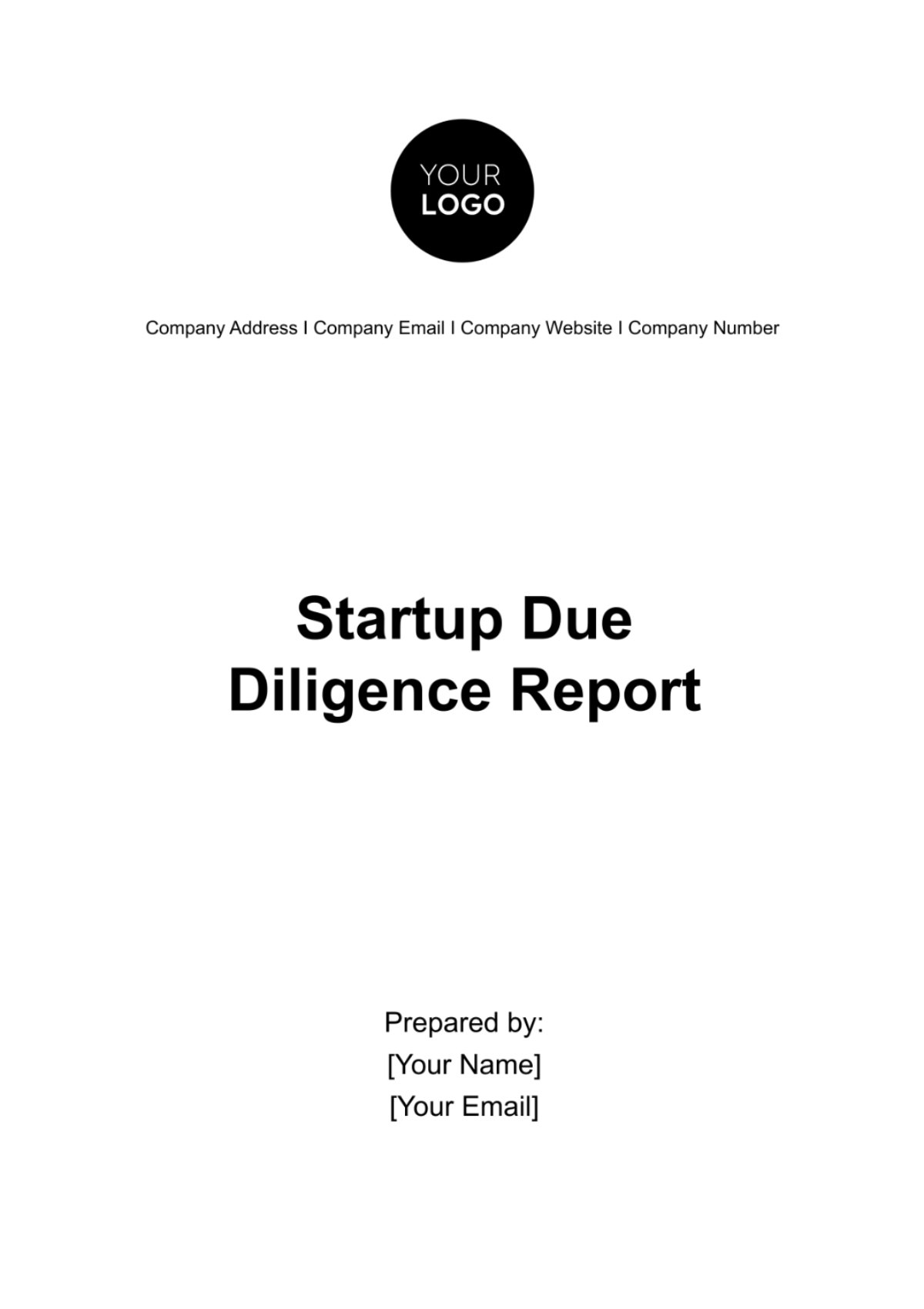Startup Investor Due Diligence Report
Executive Summary
The purpose of this report is to provide a detailed and comprehensive due diligence review of [Startup Company Name], a burgeoning player in the [industry sector] landscape. Our objective is to meticulously evaluate critical components such as financial performance, management efficacy, market dynamics, and the overarching business strategy to offer a holistic view of the startup's potential and risks. This in-depth analysis is designed to equip prospective investors with the necessary insights to gauge the viability and growth prospects of [Startup Company Name].
Structured to facilitate ease of understanding, the report is divided into distinct sections, each dedicated to a specific area of analysis. These sections are succinctly summarized in tables that highlight the principal findings, providing a quick reference point for key metrics and insights. The methodology employed in this investigation encompasses a thorough review of financial documents, strategic plans, and operational records, complemented by insightful interviews with the startup's key executives and team members. This blend of quantitative and qualitative analysis ensures a well-rounded assessment of [Startup Company Name]'s position and potential in its market.
Financial Overview
The financial health of [Startup Company Name] is scrutinized in this section, presenting a clear picture of its fiscal stability, growth trajectory, and financial management acumen. An in-depth analysis of the audited financial statements from the past five years forms the backbone of this evaluation, shedding light on the startup's revenue growth, expense management, net income trends, and cash flow dynamics.
Revenue Growth and Profitability
An upward trend in revenue is observed, starting from $[300,000] in [2050] to $[550,000] by [2054], indicating a robust growth trajectory. This growth is attributed to the startup's innovative products/services, market expansion strategies, and effective customer acquisition efforts. Profitability, as illustrated by net income, has shown a healthy increase from $[50,000] to $[200,000] over the same period, underscoring the company's improving operational efficiency and cost management.
Liquidity and Solvency
Liquidity ratios, such as the current ratio and quick ratio, are analyzed to determine the startup's ability to meet short-term obligations. The data indicates a stable liquidity position, ensuring that [Startup Company Name] can effectively manage its working capital requirements and short-term liabilities. Solvency ratios, including debt-to-equity and interest coverage ratios, reveal a conservative capital structure with a reliance on equity financing over debt, minimizing financial risk and enhancing financial stability.
Cash Flow Analysis
Cash flow analysis reveals a consistent positive cash flow from operations, indicating strong operational efficiency and effective cash management practices. The increasing trend in cash flow, from $[80,000] in [2050] to $[150,000] by [2054], demonstrates the startup's capacity to generate sufficient cash to fund growth initiatives, invest in new opportunities, and sustain its operations without overly depending on external financing.
Financial Trend Forecasting
Based on historical financial data, predictive analytics are employed to forecast future financial trends for [Startup Company Name]. These projections suggest continued revenue growth, albeit at a potentially moderated pace due to market saturation and increased competition. Profit margins are expected to remain healthy, supported by ongoing innovation, operational efficiencies, and strategic market positioning.
The tabulated summary provides an overview of the startup’s financials:
Year | Revenue | Expenses | Net Income | Cash Flow |
|---|---|---|---|---|
2050 | $300,000 | $250,000 | $50,000 | $80,000 |
[Year] | $[Amount] | $[Amount] | $[Amount] | $[Amount] |
[Year] | $[Amount] | $[Amount] | $[Amount] | $[Amount] |
[Year] | $[Amount] | $[Amount] | $[Amount] | $[Amount] |
[Year] | $[Amount] | $[Amount] | $[Amount] | $[Amount] |
Evaluation of Management
The management team at [Startup Company Name] plays a pivotal role in steering the company towards its strategic goals and operational milestones. This section delves into the capabilities of the management team, assessing their ability to navigate business challenges, capitalize on opportunities, and drive the startup towards sustained growth and profitability.
Leadership and Vision
At the helm of [Startup Company Name] is a team of seasoned professionals, each bringing a wealth of experience from various industry sectors. Their collective vision has been instrumental in defining the company's strategic direction, setting it apart in a crowded marketplace. The leadership's ability to foresee industry trends and align the startup's objectives accordingly has been a key factor in its rapid growth.
Strategic Achievements
Under the guidance of the senior management, [Startup Company Name] has witnessed remarkable financial growth, particularly in [Year], where a strategic pivot or a new product launch significantly enhanced revenue streams. This achievement not only highlights the team's ability to identify and leverage new opportunities but also underscores their commitment to sustainable growth.
The implementation of a cost-cutting strategy, without compromising on product quality or workforce morale, stands out as a testament to the management's operational prowess. This strategic move improved the company's profitability margins, making it more resilient against financial volatilities.
One of the notable successes of the management team has been in forging strategic partnerships. These alliances have not only expanded the company's operational capabilities but have also opened up new market segments, contributing to a diversified and robust business model.
The team's strategic foresight and aggressive market penetration strategies have facilitated the company's entry and establishment in new geographic markets. This expansion has not only increased the customer base but has also enhanced brand visibility and recognition on a global scale.
Areas for Improvement
Despite these successes, the management team has faced challenges, particularly in project management, where delays in certain initiatives resulted in financial setbacks. These experiences underscore the need for improved project oversight and risk management strategies to mitigate similar occurrences in the future.
Market Analysis
[Startup Company Name] operates in a dynamic and highly competitive environment, where innovation and adaptability are crucial for survival and growth. This section provides an in-depth analysis of the market conditions, competitive landscape, and the startup's position within this ecosystem.
Competitive Landscape
Despite the presence of well-established competitors, [Startup Company Name] has successfully carved out a niche for itself. This success can be attributed to its innovative approach to solving customer problems, its agile business model, and its ability to rapidly adapt to market changes. The startup's unique value proposition, combined with its customer-centric focus, has allowed it to differentiate itself and gain a foothold in the market.
Innovation and Adaptability
Innovation is at the core of [Startup Company Name]'s strategy. Its commitment to continuous improvement and adaptability has positioned it as an innovative force in the industry. The startup's ability to anticipate customer needs and evolve its offerings accordingly has not only enhanced customer satisfaction but has also enabled it to stay ahead of industry trends.
Market Growth and Opportunities
The target market for [Startup Company Name] is characterized by a high growth rate, presenting numerous opportunities for expansion and diversification. The startup's strategic market analysis and customer insights have enabled it to identify emerging trends and areas for potential growth, ensuring that it remains aligned with market demands.
Challenges and Risks
While the market presents significant growth opportunities, it is not without its challenges. Environmental and technological trends pose potential risks that could impact the startup's operations and market position. Regulatory changes, shifts in consumer behavior, and technological disruptions are some of the critical factors that the management team needs to continuously monitor and address to maintain the company's competitive edge.
Pricing Strategy
One of the strategic advantages of [Startup Company Name] is its competitive pricing model. By offering high-value products/services at competitive prices, the startup has been able to attract and retain a broad customer base. This pricing strategy, coupled with exceptional customer service and product quality, has been pivotal in building customer loyalty and driving revenue growth.
The comprehensive analysis of the management team and market dynamics provides a nuanced understanding of [Startup Company Name]'s operational strengths, strategic achievements, and potential growth areas. While the management team has demonstrated a remarkable ability to lead the company towards success, continuous improvement in areas such as project management and risk mitigation will be crucial. Similarly, a deep understanding of the market environment, along with a focus on innovation and adaptability, will ensure that [Startup Company Name] remains competitive and continues to thrive in its respective industry.
Conclusions Insights
This due diligence report of [Startup Company Name] will enable [YOUR COMPANY NAME] to understand the startup's current standing and future potential. The systematic overview and assessment provided within this report will also shed light on potential risks or liabilities associated with the investment.
[YOUR NAME] and the team behind this report believe that the comprehensively captured information will act as a baseline for [YOUR COMPANY NAME] to make informed decisions pertaining to the possible investment in [Startup Company Name].



































